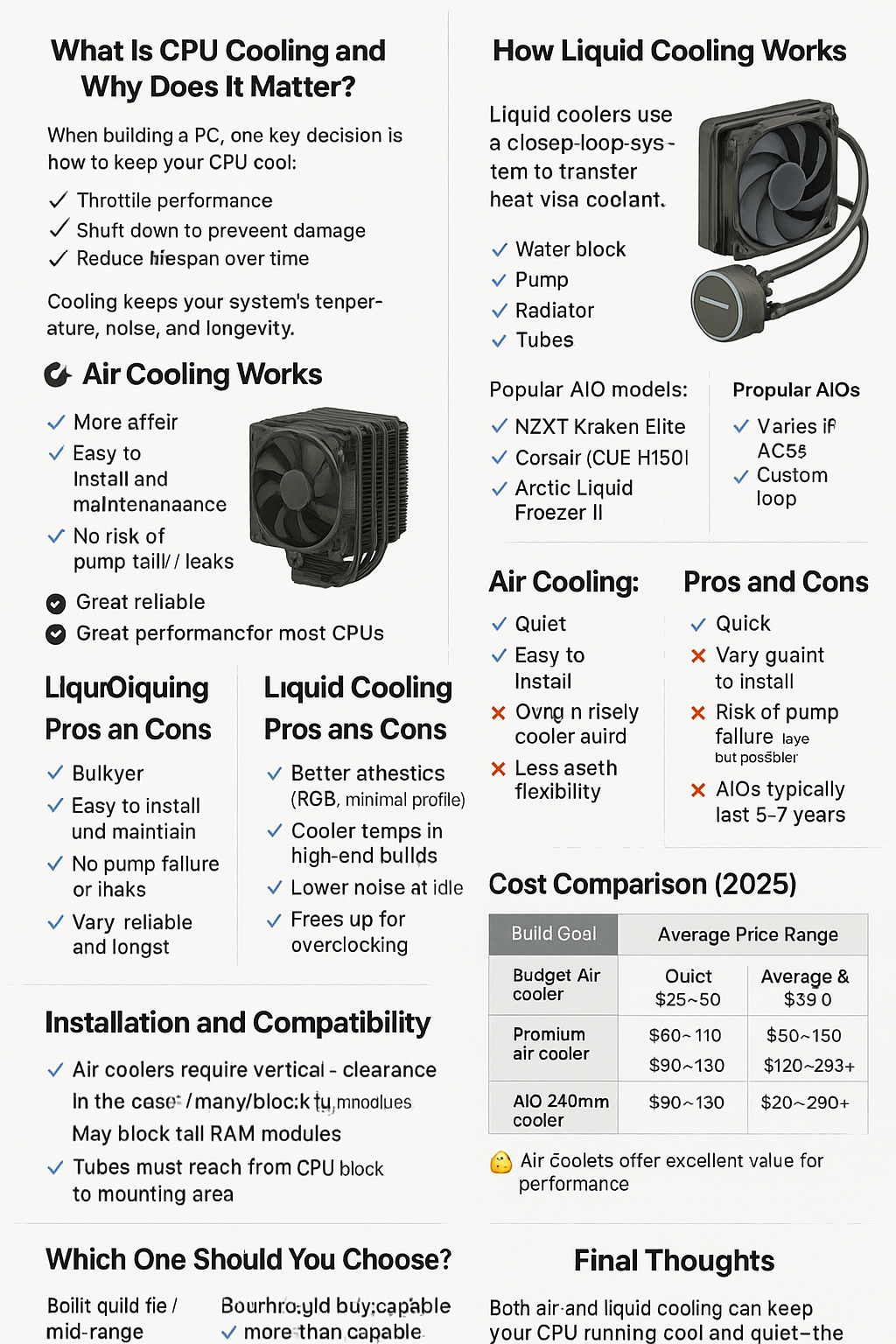When building a PC, one key decision is how to keep your CPU cool: air cooling or liquid cooling? Each method has pros and cons — and choosing the right one can impact your system’s temperature, noise, and longevity.
In this guide, you’ll learn the difference between air and liquid cooling, how each works, and how to decide what’s best for your build.
What Is CPU Cooling and Why Does It Matter?
The CPU generates heat during operation. Without proper cooling, it can:
- Throttle performance
- Shut down to prevent damage
- Reduce lifespan over time
Cooling keeps your system stable and allows for peak performance, especially during gaming, video editing, and multitasking.
1. How Air Cooling Works
Air coolers use metal heatsinks and fans to draw heat away from the CPU.
Components:
- Baseplate (contacts the CPU)
- Heatpipes (transfer heat upward)
- Fins (dissipate heat)
- One or more fans (blow air through the fins)
Popular models:
✅ Noctua NH-D15
✅ be quiet! Dark Rock Pro 5
✅ Cooler Master Hyper 212
2. How Liquid Cooling Works
Liquid coolers use a closed-loop system to transfer heat using coolant.
Components:
- Water block (mounted on CPU)
- Pump (circulates fluid)
- Radiator (releases heat via fans)
- Tubes (connect everything)
Types:
- AIO (All-in-One) – sealed, maintenance-free
- Custom loop – DIY system for enthusiasts
Popular AIO models:
✅ NZXT Kraken Elite
✅ Corsair iCUE H150i
✅ Arctic Liquid Freezer II
3. Air Cooling: Pros and Cons
✅ Pros:
- More affordable
- Easy to install and maintain
- No risk of pump failure or leaks
- Very reliable and long-lasting
- Great performance for most CPUs
❌ Cons:
- Bulkier — can interfere with RAM or case clearance
- Can be louder under heavy load
- Less aesthetic flexibility
4. Liquid Cooling: Pros and Cons
✅ Pros:
- Better aesthetics (RGB, minimal profile)
- Cooler temps in high-end builds
- Lower noise at idle
- Great for overclocking
- Frees up space around the CPU
❌ Cons:
- More expensive
- More complex to install
- Risk of pump failure (rare, but possible)
- AIOs typically last 5–7 years
5. Performance Comparison
| Load Type | Air Cooler | AIO Liquid Cooler |
|---|---|---|
| Idle temps | Quiet, effective | Very quiet |
| Gaming load | Good performance | Often slightly cooler |
| Overclocking | Limited (mid-tier) | Excellent cooling |
| Noise level | Varies | Quieter with larger rads |
| Lifespan | 5–10+ years | 4–7 years (AIOs) |
💡 For most users, both solutions are more than capable — the difference matters more in high-performance systems.
6. Installation and Compatibility
Air Coolers:
- Require vertical clearance in the case
- May block tall RAM modules
- Easier to swap in/out
Liquid Coolers:
- Radiator must fit case (120mm, 240mm, 360mm)
- Tubes must reach from CPU block to mounting area
- May require top, front, or side radiator support
📌 Always check case and motherboard compatibility before buying.
7. Cost Comparison (2025)
| Cooler Type | Average Price Range |
|---|---|
| Budget Air Cooler | $25 – $50 |
| Premium Air Cooler | $60 – $110 |
| AIO 240mm Cooler | $90 – $130 |
| AIO 360mm Cooler | $120 – $200+ |
💰 Air coolers offer excellent value for performance.
8. Maintenance Requirements
Air Coolers:
- Clean dust from heatsink and fans every 2–3 months
- Reapply thermal paste every 1–2 years
Liquid Coolers (AIOs):
- Clean radiator and fans
- No need to refill coolant
- Watch for pump wear or noise over time
Custom Loops:
- Require regular flushing and refilling
- Not beginner-friendly
9. Aesthetics and RGB Considerations
Liquid cooling setups often look cleaner and more modern — especially in showcase builds. Many AIOs include:
- RGB lighting
- LCD displays for temps or logos
- Custom cable management options
However, some air coolers (like Noctua Chromax or DeepCool Assassin) also look great and come with RGB variants.
10. Which One Should You Choose?
| Build Goal | Recommended Cooler |
|---|---|
| Budget or mid-range gaming PC | Premium air cooler |
| Silent or low-profile build | AIO with large radiator |
| Overclocked high-end CPU | AIO (280mm or 360mm) |
| Hassle-free, long-term use | Air cooler |
| Aesthetic-focused showcase build | AIO with RGB/LCD |
Final Thoughts
Both air and liquid cooling can keep your CPU running cool and quiet — the key is to choose based on your performance needs, budget, and build goals.
✅ Air cooling is great for most users: affordable, reliable, and simple
✅ Liquid cooling is ideal for enthusiasts: quieter, cooler, and sleeker
Whichever you choose, make sure it fits your case, matches your CPU’s power level, and keeps your system running strong.
